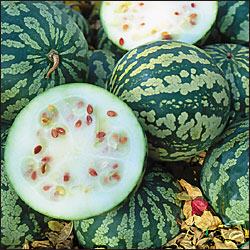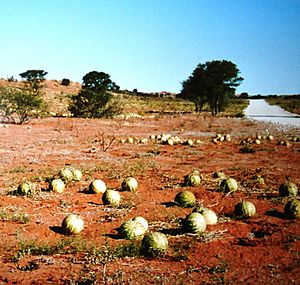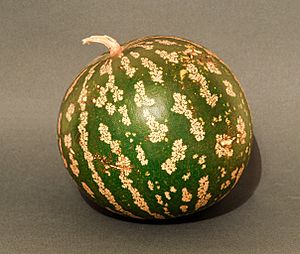Citron melon facts for kids
Quick facts for kids Citron melon |
|
|---|---|
 |
|
| Scientific classification | |
| Genus: |
Citrullus
|
| Species: |
caffer
|
| Synonyms | |
|
|
The citron melon (Citrullus caffer) is a plant that is a close relative of the watermelon. It is also known by many other names. These include Citrullus amarus, fodder melon, preserving melon, red-seeded citron, jam melon, stock melon, Kalahari melon or tsamma melon.
This plant is part of the Cucurbitaceae family. This family includes many different squashes, melons, and gourds. The citron melon originally grew in the dry lands of sub-Saharan Africa. For a very long time, it has been a natural source of food and water for people there.
The fruit of the citron melon has firm, white flesh. Because of this, it is not often eaten raw today. Instead, people usually pickle it or use it to make fruit preserves. It is also used as food for farm animals. It is especially good for making preserves because it has a lot of pectin. Pectin is a natural substance that helps jams and jellies set.
History of the Citron Melon
The citron melon comes from Africa. It likely started in the Kalahari Desert, where it still grows in large amounts. We don't know exactly when or where it was first grown by humans. However, people in ancient Egypt were growing it at least 4,000 years ago.
Today, it is grown as food in many parts of Africa. This is especially true in dry or desert areas, like South Africa. In some places, it even provides water during dry seasons.
In South Africa, the Xhosa people often eat it. They call it Intyabontyi. They might eat it raw or cooked.
The citron melon is now found and grown in other parts of the world too. In the southern plains states of the United States, it is sometimes called pine melon.
It has also started growing wild in western Mexico. There, it is considered an invasive species. This means it grows where it is not native and can sometimes cause problems for local plants.
What the Citron Melon Looks Like

The fruit of the citron melon looks a lot like a regular watermelon. However, it is usually smaller and more round. The inside of the melon is whiter and very firm. Its taste is much stronger than a watermelon. It tastes more like the white part of a watermelon rind, near the red flesh. While some people do eat it raw, it is usually cooked or prepared in other ways.
The leaves of the citron melon plant change as they grow. When they are young, they look like a hand with fingers spread out. As they get older, they become deeply lobed, meaning they have deep cuts in their edges. The leaves feel rough and have clear white lines, called venation.
The plant has single flowers that grow alone. They have large, yellow petals that are about 2 to 10 millimeters long. These flowers are spread out on the plant. They produce many fruits that have a mix of light green and dark green patterns on their skin.


